This post has been divided into two parts:
-Part I describes some of the major terrain features in brief along with relevant pictures from my treks in the Sahyadri range. Their cartographic representations have been added, wherever possible.
-Part II describes Forts and their parts. Link to the second part can be found at the bottom of this page.
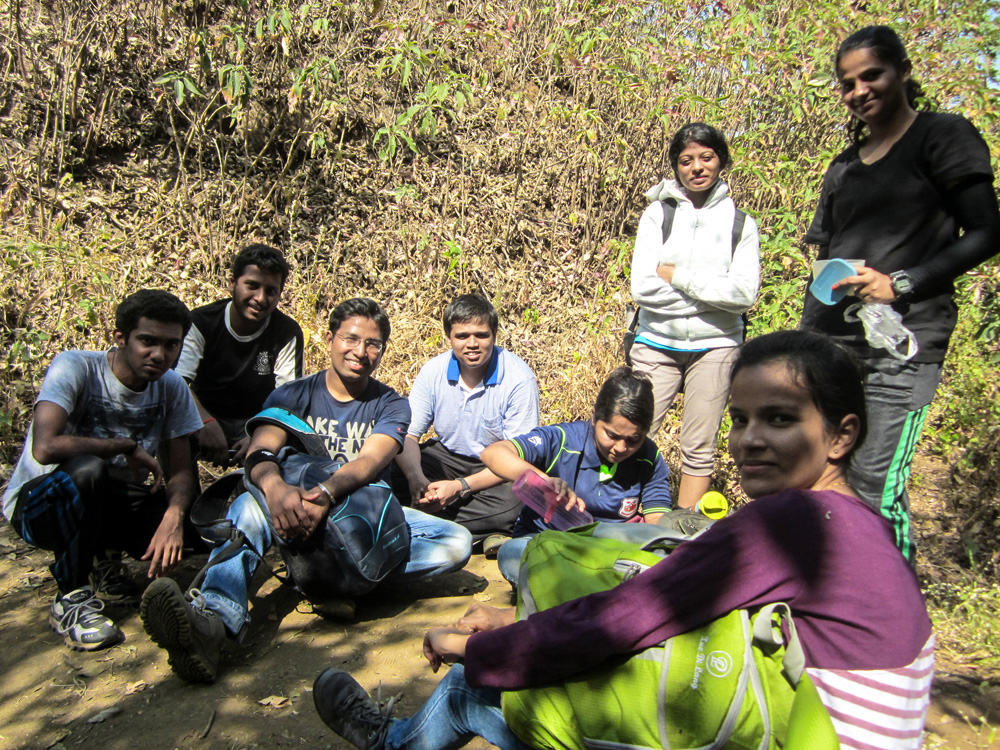
You might have seen this picture before. It’s from the very first trek of ‘A Season Of Mountains’- Vikatgad in Jan ’15.
It’s a pretty routine picture- tired but happy faces taking a break during the climb. Except, it isn’t.
About half an hour before this picture was clicked at the Col, we were bang in the middle of a forest with no visible path. It was a weekday, so we were pretty much the only trekkers on the hill and moreover, hours behind the schedule we had drawn up. Despite spending a week going through blogs and creating a map of the trail, we ended up overshooting our turn to the naal by 3 hills. Yep, three freaking hills. And by the time we realised we had embarked on a rarely used, longer trail to Vikatgad, we were at the point of no return.

The lowest point of the range, Col, was the only landmark we knew on the longer trail. So we walked, stumbled and crawled our way through the forest to somehow reach that Col and that might just be the reason we ended up in our beds that night instead of the newspaper headlines the next morning.
That day, I realised the importance of identifying various terrain features but it still took me a good dozen-odd treks to learn how to navigate the trail using them as landmarks.
This is my attempt at listing them all in one place!
Note: There’ll be lots of notes in this post 😛
Part I: LANDFORMS
Let’s start with a little info about our region of interest- The Western Ghats.
WESTERN GHATS
The Western Ghats, a UNESCO world heritage site[1] and one of the eight hottest hotspots of the world[2], run parallel to the Arabian Sea along the western coast of India. Starting from the Tapi River near Surat in Gujarat, they extend approx. 1600 km in the north-south direction, passing through the states of Maharashtra, Goa, Karnataka, Kerala and Tamil Nadu to end near the southernmost tip of India, Kanyakumari.
While I was looking for a map of the Western Ghats to slot in here, I was surprised to find that there isn’t a single high-resolution map available in the public domain! So I went ahead and did the only thing I know to do in such cases- I made one 😉

This is a scaled down version of the map. For the original file measuring 2851 by 5051 pixels, click on the link below.
Google Drive link of High resolution Map. (Opens in a new tab)
Although the term ‘Sahyadri’ is widely used to describe the entire Western Ghats, geographically, it is a segment of the Ghats[3] like the Nilgiri, Anamalai, Cardamom & Ashambu hills[5-10]. Specifically, the northern part of the Western Ghats upto the Terekhol river in Goa, spanning 650 km, is called the Sahyadri Range [4].
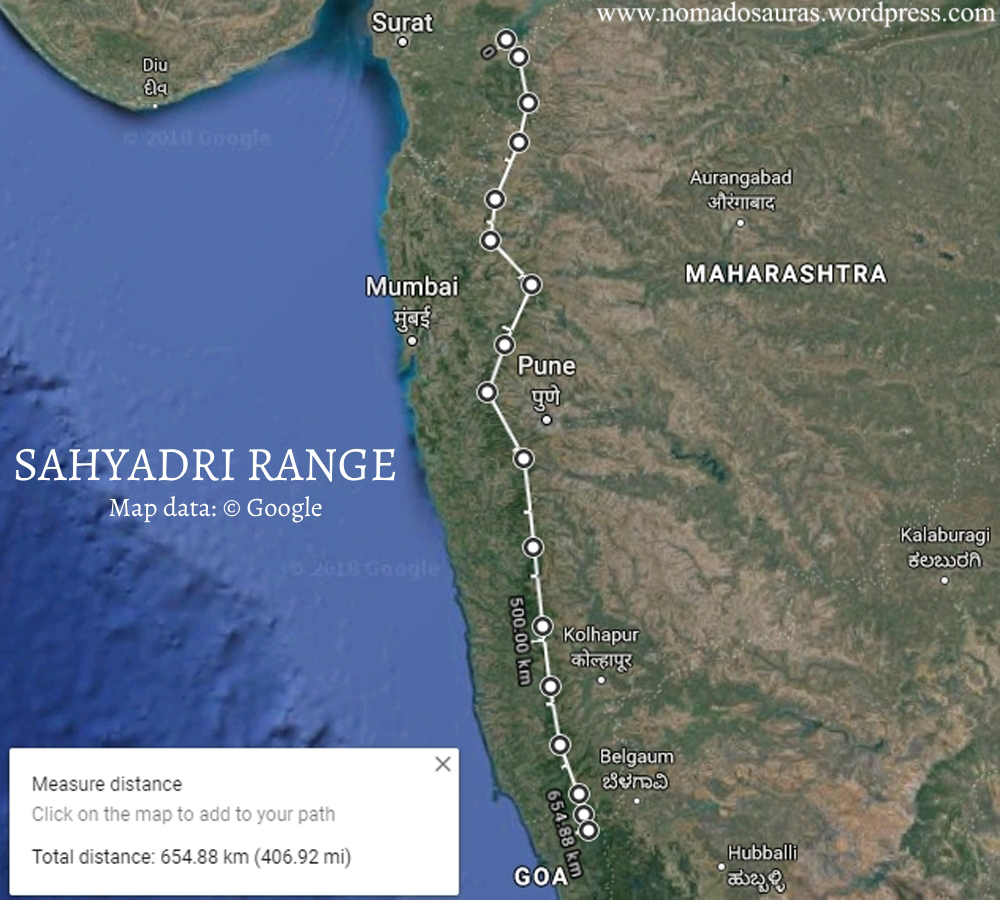
TERRAIN FEATURES:
The Sahyadri hills are home to a number of different terrain features and identifying as well as understanding them can be a source of great joy! As you get familiar with a region, you start looking out for the peaks like you would for an old friend. As if that isn’t enough, it can also come in handy during emergencies when one has to relay/pinpoint someone’s location.
Note: 1. The feature’s Marathi names (in the Devanagari as well as Latin scripts) have been provided to help understand the signs, maps and markers (usually inscribed in Marathi) found at regular intervals on the trail.
2. I have refrained from using topographical jargon but some terms do not have an equivalent in the layman’s language and therefore, have been used as a last resort.
Cave (गुहा/Guha)
The caves found in the Sahyadri range are prominently rock shelters — a shallow cave-like opening at the base of a cliff/hill formed out of erosion. Most of the caves sport intricate carvings and in some cases, scriptures as well.

Buddhist rock-cut caves on the other hand, are elaborate cave complexes with stupas and gigantic statues often carved into the rock walls.
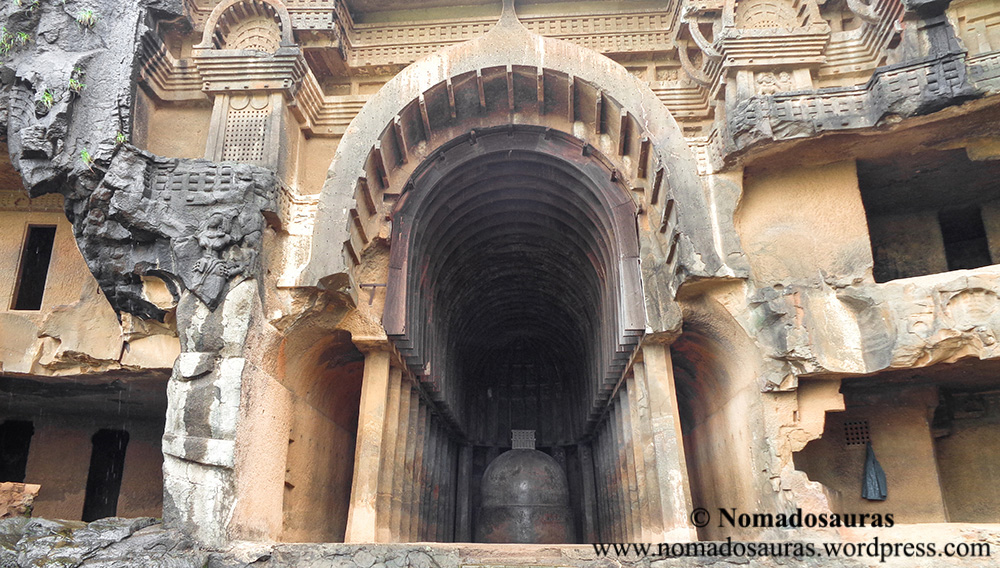
Other well known examples include the Ganpati Gadad caves near Murbad and Kondheshwar caves near near Karjat.
Chimney
Chimneys are a very steep narrow cleft, cracks or fissures in cliffs, by which a rock face may be climbed. Most of the chimney sections in the Sahyadri are too dangerous to be attempted by anyone except professional rock climbers but fret not! People like you and me can still experience the thrill of pushing up the narrow walls with your back, courtesy Padargad! 😀
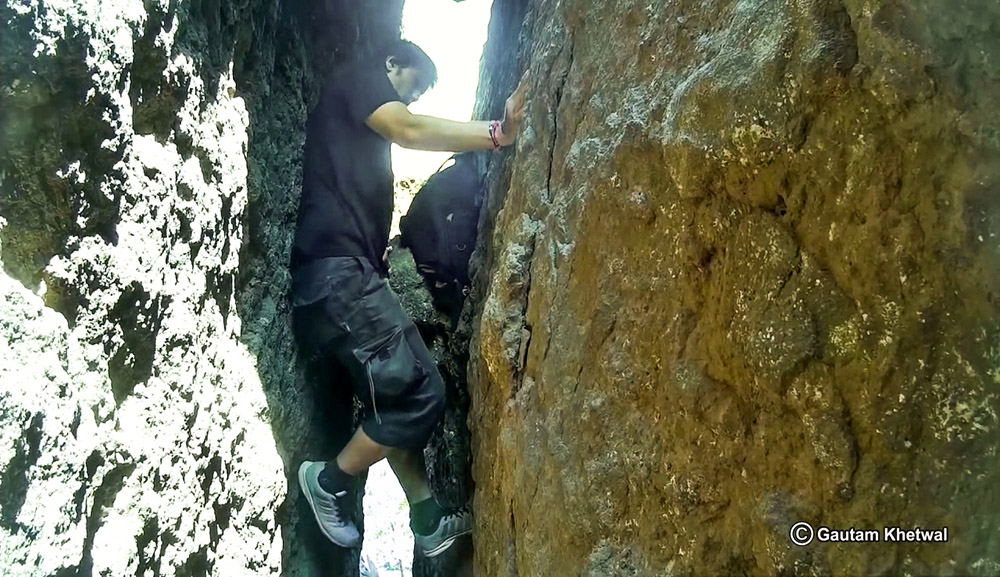
Cliff (कडा/Kada)
A cliff is a vertical, or nearly vertical, rock face formed by the processes of weathering and erosion. The Konkan Kada, is the most famous example of a cliff in the Sahyadri.

The 1800 feet high concave cliff has been climbed only twice since the first ascent in 1985. Reason? Look at it yourself!

Col
A col is the lowest point on a mountain ridge between two peaks.

You have already got acquainted with the Nakhind-Vikatgad col at the beginning of this post. Here’s the col on the other side of Vikatgad- between Matheran and the southern bastion of Vikatgad.
a.

b.

Draw (नाळ/Naal)
A draw is formed by two parallel spurs with low ground in between them.
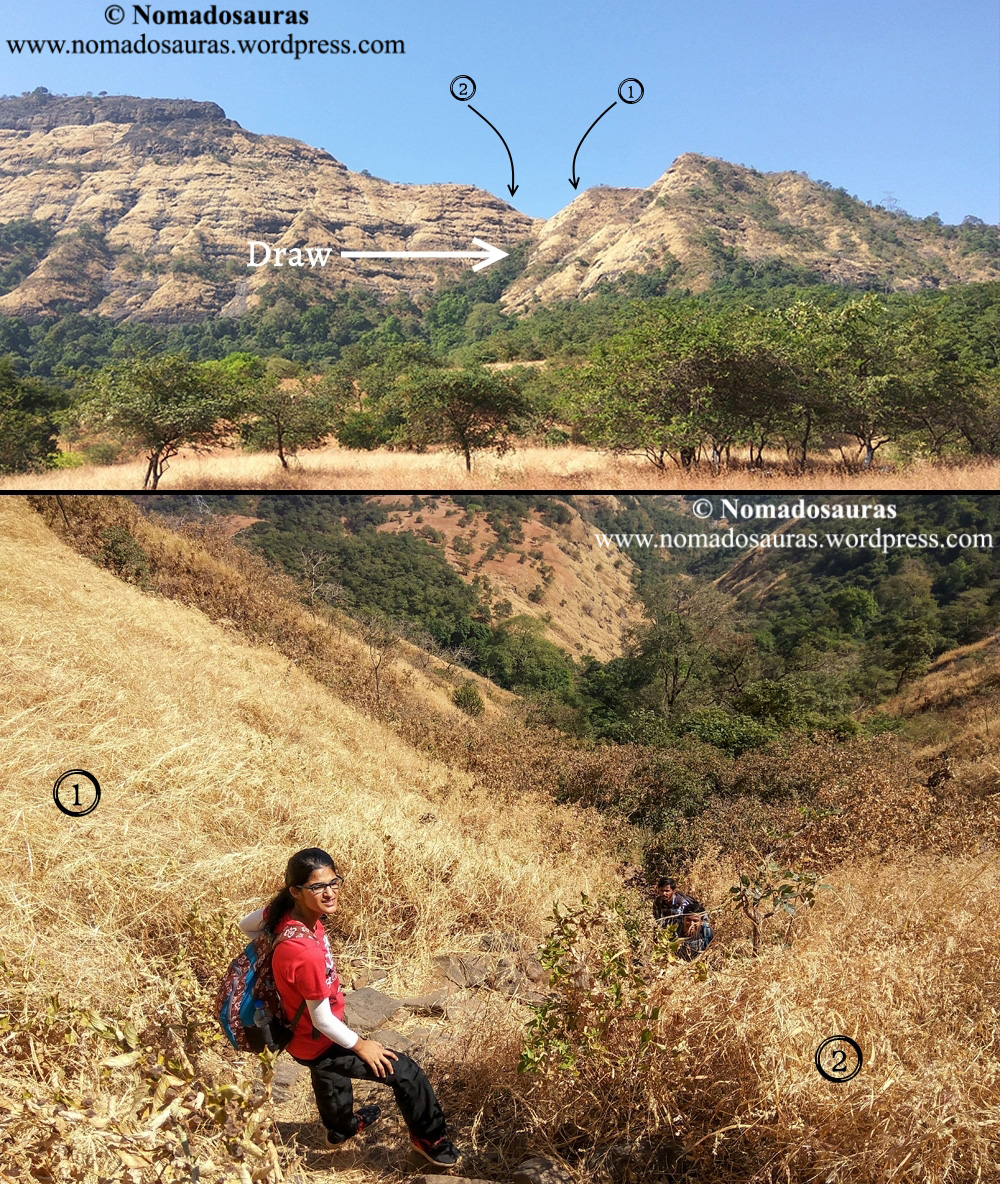
It is usually etched in a hillside by water flow and may contain an ephemeral stream or loose rocks from the eroded rock fall.
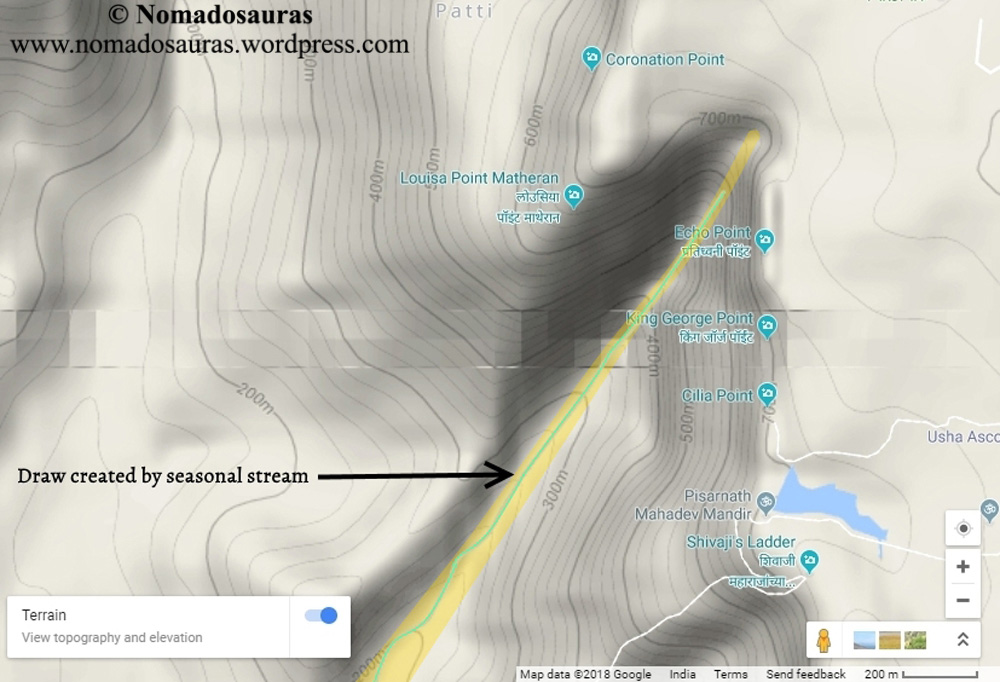
The very first Naal ascent I did was back in July ’15 when 8 of us climbed an 80 m high naal near the Pisarnath Mandir of Matheran during a torrential downpour. Sahyadri trekkers are a creative bunch, as is evident from the unique names they often give to certain routes. So you know a naal isn’t supposed to be taken lightly when they drop the tongue-in-cheek humour and instead name a route so as to clear any doubts you might have about its difficulty. The popular name of the Pisarnath ladder route? Danger trail 😛
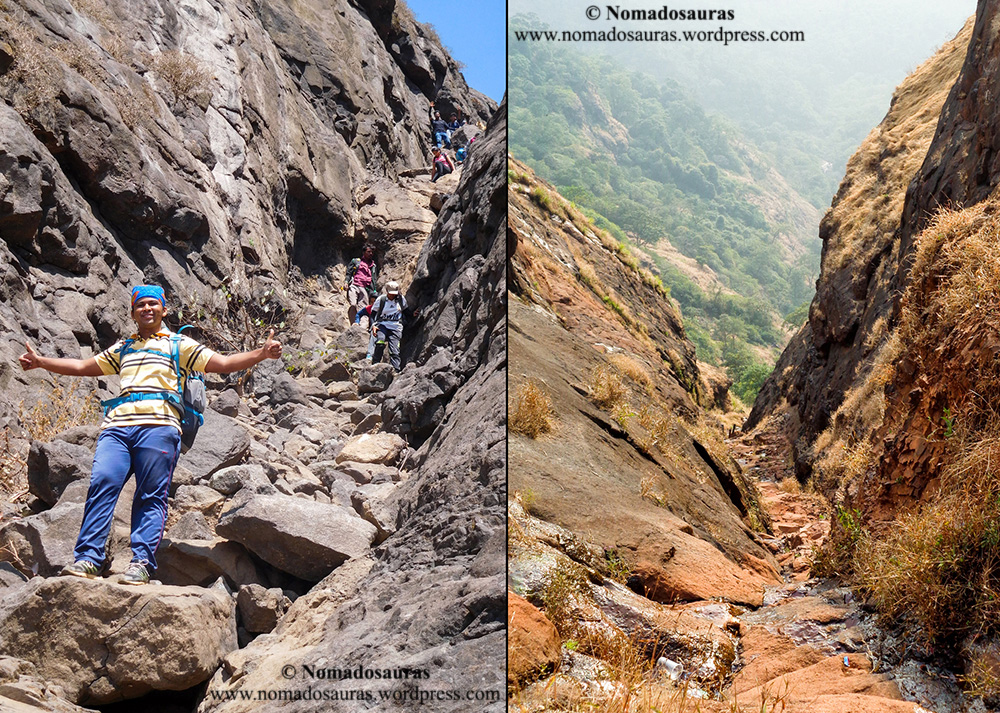
Harishchandragad via Nalichi Vaat, Hadsar via Naal, Dhak Bahiri via the Kalakrai Naal are some other famous naal trails in Sahyadri.
Hill (डोंगर/Dongar)
A hill is a landform that extends above the surrounding terrain. It often has a distinct summit, although in areas with scarp/dip topography a hill may refer to a particular section of flat terrain without a massive summit. Mountains generally are understood to be larger than hills, but the term has no standardized geological meaning.
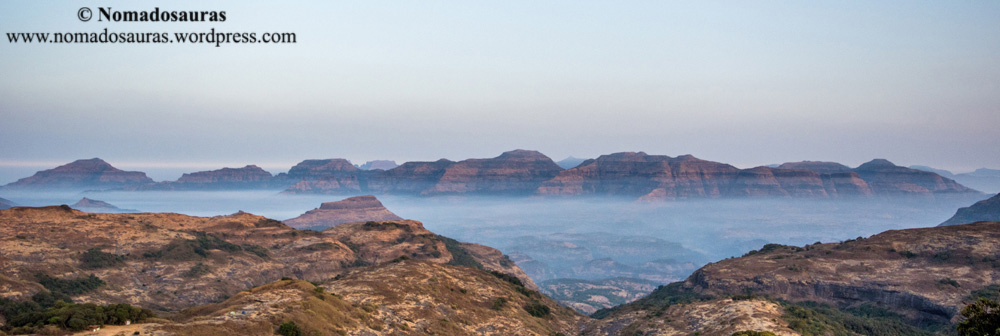
The highest peak of Maharashtra, Kalsubai is the best known example of a non-fort hill. I‘ll like to take this opportunity to mention a fun fact- even though Kalsubai is the highest peak of Maharashtra, it isn’t the highest climb in the Sahyadri. That honour belongs to Kulang fort.
How? Google ‘Topographic Prominence’ 😉
Hillock (टेकडी/Tekdi)
A small hill or mound.

Simply put, Hillock is the Peter Pan of the geological world who (literally!) refused to grow up! 😛
Needle Hole (नेढे/Nedhe)
I got news for you. Nature has it’s own

Except it is a hole formed in a rock face due to weathering/erosion. 😛
Madangad, Irshalgad, Kothaligad, Rajgad, Nakhind, Ratangad, Harishchandragad are a few forts which can boast of this relatively rare terrain feature!

Know more? Drop me a mail using the contact form! 😀
Saddle (खोगीर/Khogir)
A Saddle is a dip or low point between two areas of higher ground, often inline. When a saddle can navigated on foot, it is known as a pass.
Pass (घाट/ खिंड-Ghat/Khind)
1: A pass is a navigable route through a mountain range or over a ridge.
2: A pass is a gap, or break, in high, rugged terrain such as a mountain ridge. Passes often provide the easiest routes for people to travel across steep mountain ranges.

Naneghat is perhaps the most important pass of the Sahyadri (from the point of view of trade).
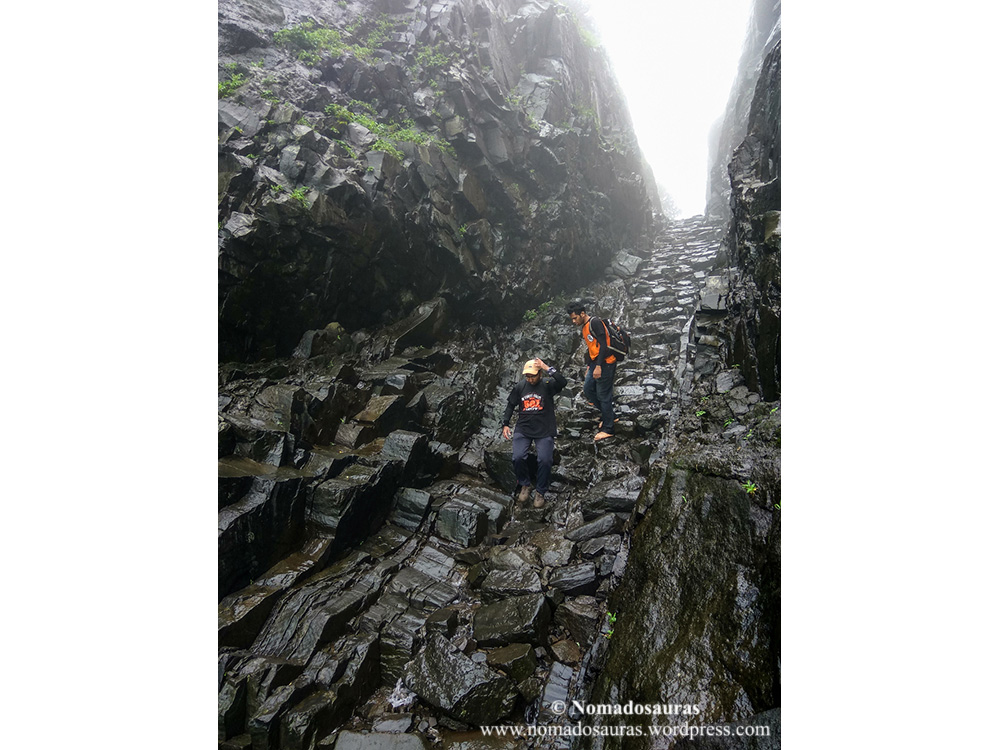
Legend has it that the huge pot used for collection of toll from the traders using the pass would fill up three times a day! And it still sits pretty besides the pass reminding us of the bygone era.
Peak (शिखर / टोक– Shikhar/Tok)

Err… Sorry wrong Shikhar 😛

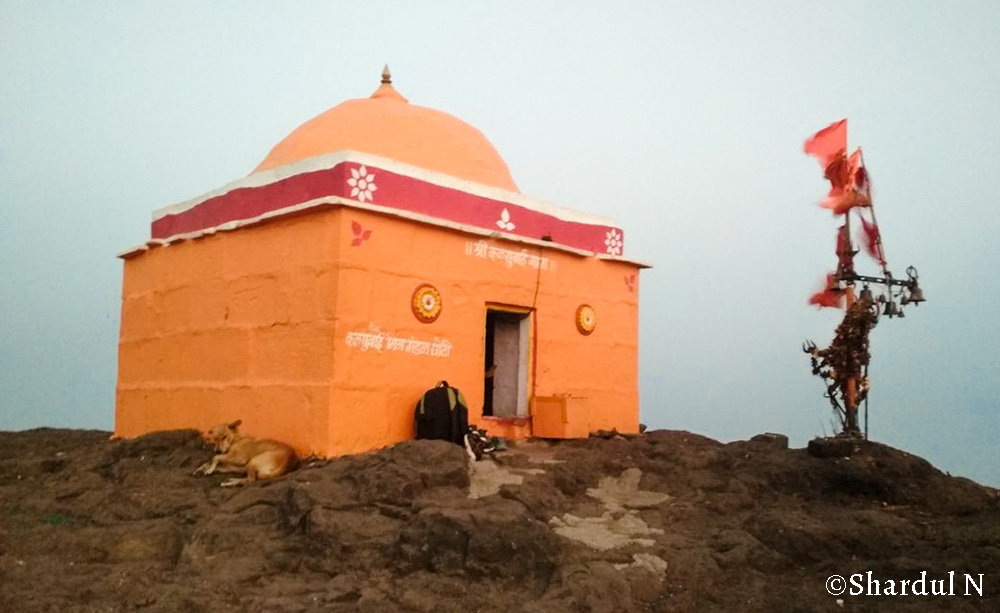
In topography, Shikhar refers to the the pointed top of a mountain or a hill.

Pinnacle (सुळका/Sulka)

A pinnacle is an individual column of rock, isolated from other rocks or groups of rocks, in the shape of a vertical shaft or spire.

Navrichi Karawli, Hadbichi Shendi, Khada parsi, Vanartok are some of the prominent pinnacles of Sahyadri. Told you, Sahyadri climbers are a creative bunch when it comes to naming! 😉
Plateau (पठार/Pathar)
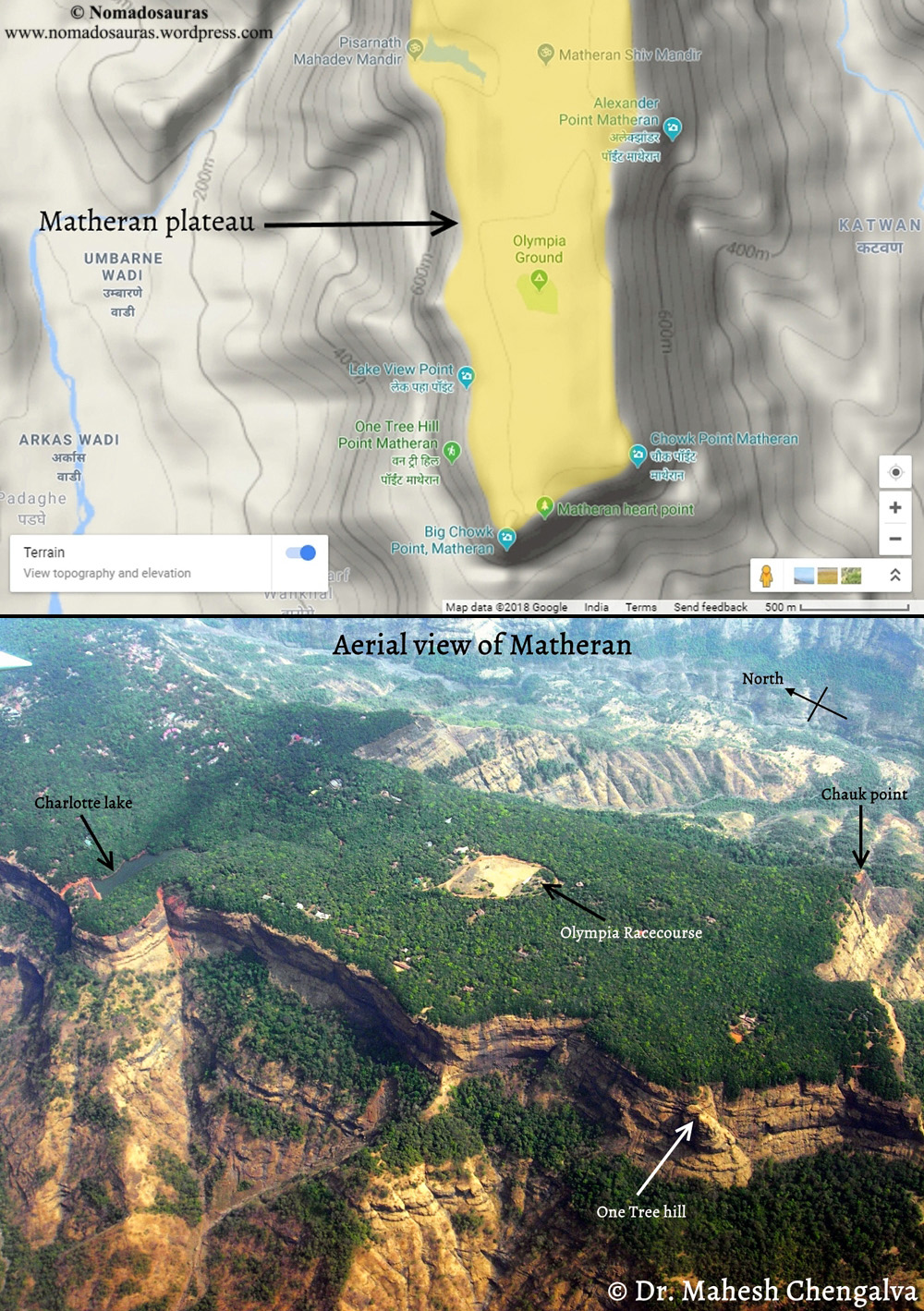
A plateau is a relatively flat, elevated landform that rises sharply above the surrounding area on at least one side and often, more sides with steep slopes.
Ridge (धार/Dhaar)

A ridge or mountain ridge is a geological feature consisting of a chain of mountains or hills that form a continuous elevated crest for some distance.
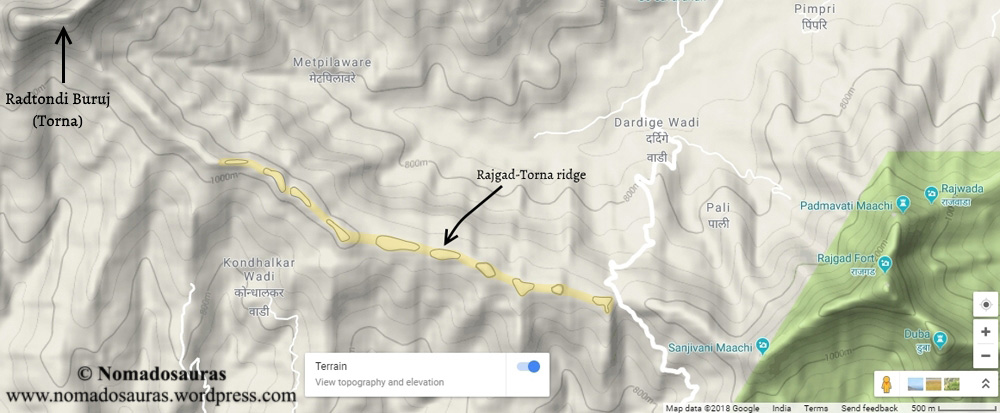
The line along the crest formed by the highest points, with the terrain dropping down on either side, is called the ridgeline.
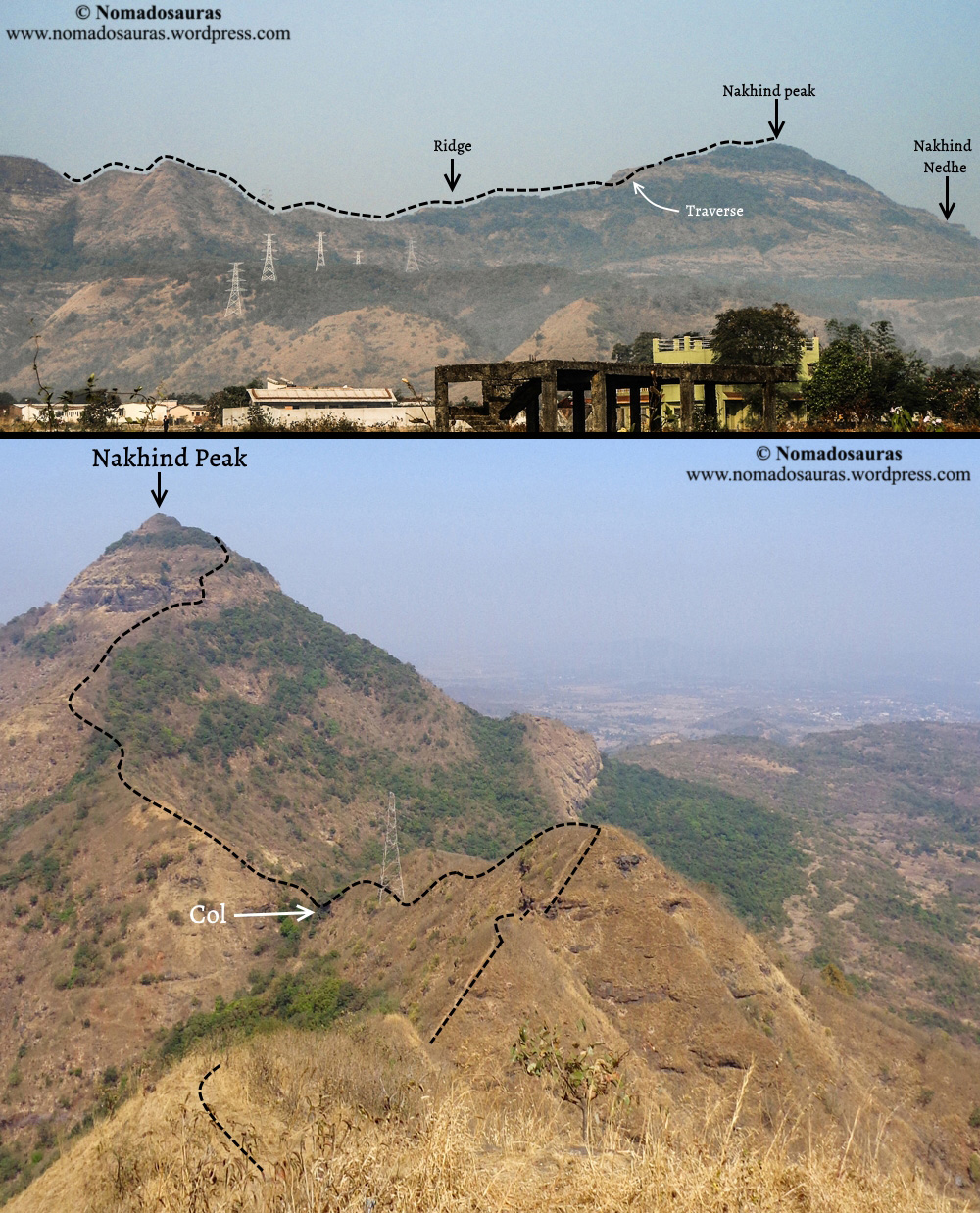
Rock Patch
A continuous rocky section (often inclined more than 45 degrees) that can be free climbed or may require climbing equipment.
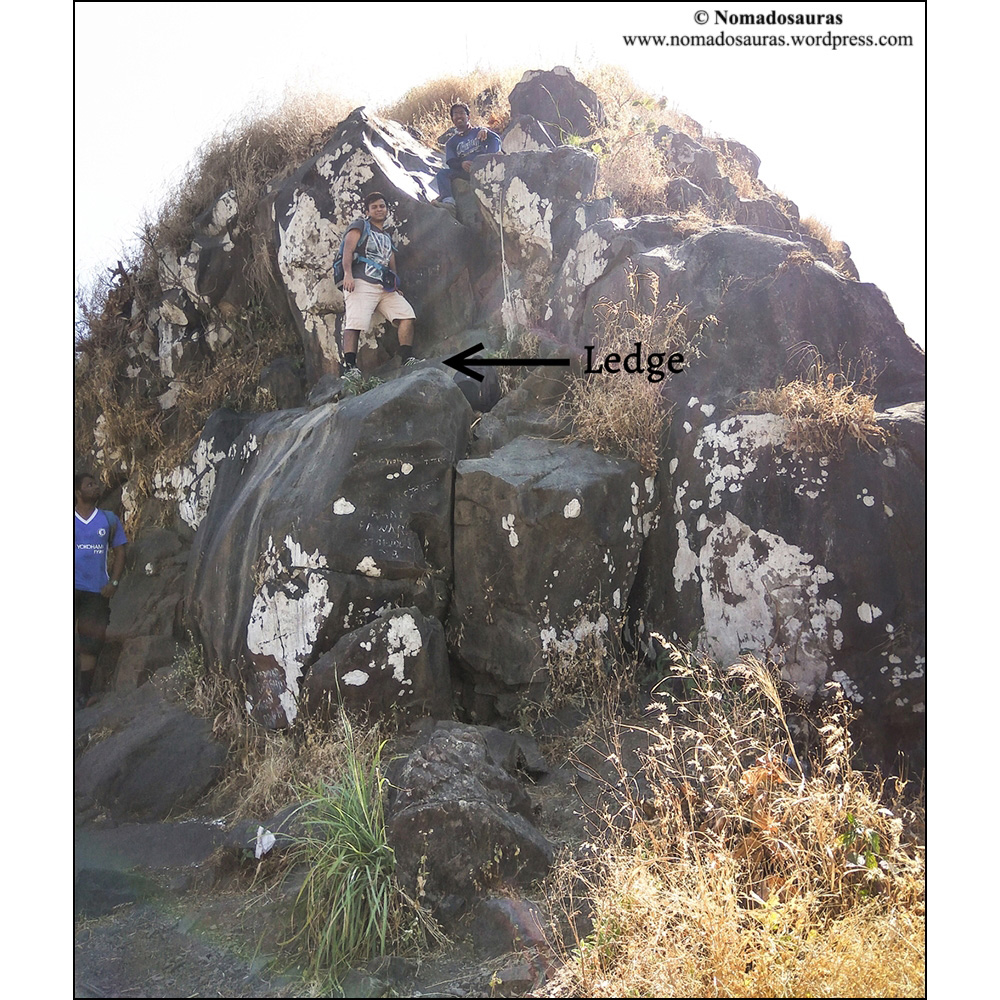
From the easy Vikatgad rock patch to the moderately risky One tree hill or the outright crazy Irshalgad pinnacle, there’s something for every climber, irrespective of your skillset 🙂 If you dream of sheer rocks walls (And I have no idea why you would do that!), then Sahyadri is the place to be!
Scarp
A scarp is a steep slope or long cliff that forms as an effect of faulting or erosion and separates two relatively levelled areas having differing elevations.
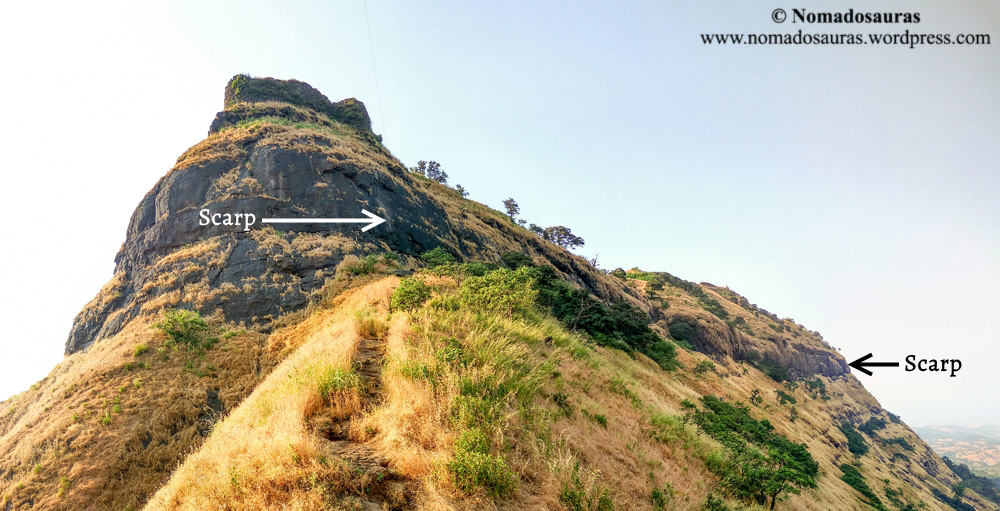
Scarp is a term encompassing a very wide range of terrain features. The Sahyadri is a 650 km long scarp of the Deccan plateau by some accounts!
Shoulder (खांदा/Khaanda)
A point at which a steep slope descends from a plateau or highland area, resembling a shoulder in shape.

Yeeup, you read that right. Mountains have shoulders. And mood swings too. I can vouch for the latter.
Spur (सोंड/Sond)

A spur is a tongue of land descending from a hill, mountain or main crest of a ridge.
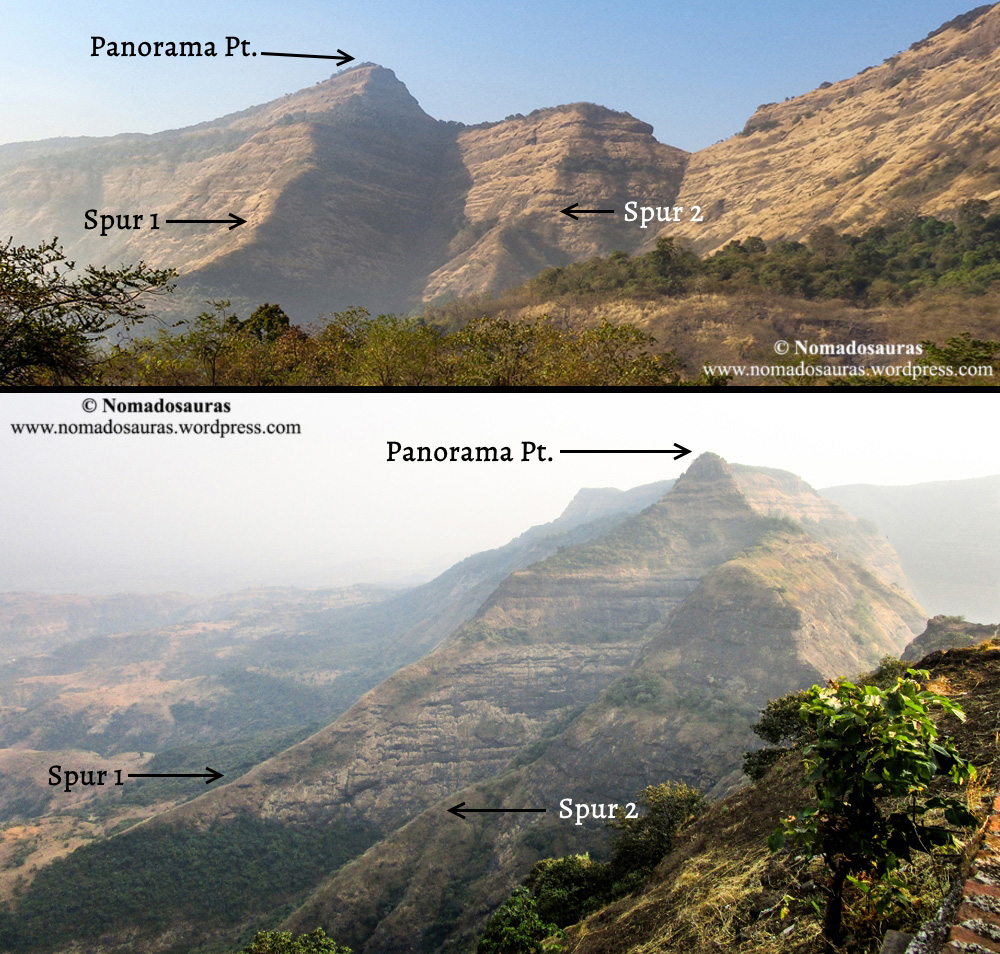
Easy way to identify a spur? Make a fist and point it towards yourself. If the knuckles represent a ridge, the fingers represent the spurs. Nope, don’t do this if you are in a public place. Unless you are Rocky Balboa.
Traverse
A traverse is a lateral move or route, mainly going sideways rather than up or down. In general mountaineering, a trail usually traverses the steep gradient of the rock face.
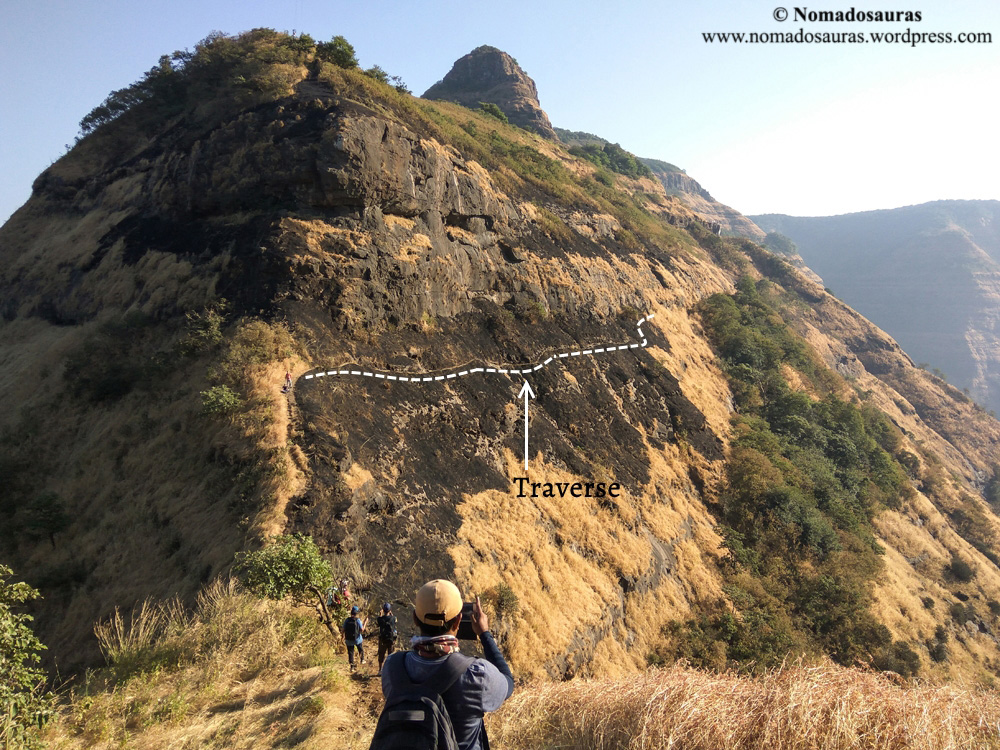
Valley (दरी/Dari)
A valley is a low area most commonly drained by rivers and may occur in a relatively flat plain or between ranges of hills or mountains.

Still confused? Here’s a rough sketch combining the different terrain features! Hope it helps 🙂
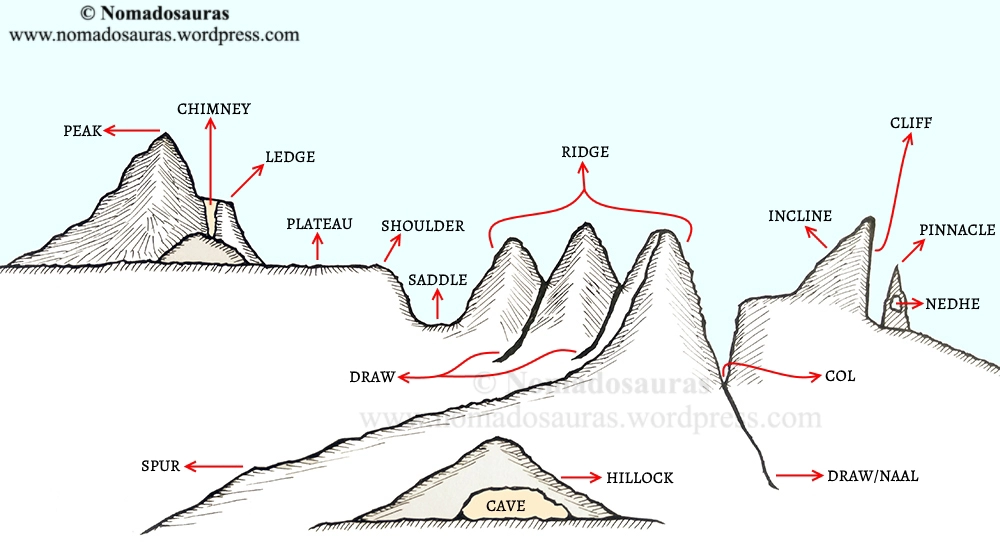
Picture credits:
Tejas Nadekar’s Flickr account
Dinesh Valke’s Flickr account
Ruturaj Vartak’s Flickr account
Safe Climbing Initiative, Pune
Gautam Khetwal’s Padargad trek video
References:
[1]: https://whc.unesco.org/en/decisions/4781
[2]: https://whc.unesco.org/en/list/1342/
[3]: https://ianlockwood.wordpress.com/2014/06/01/sahyadri-revealed/
[4]: Trek the Sahyadris, 5th Ed- Harish Kapadia
[5]: https://www.britannica.com/place/Nilgiri-Hills
[6]: https://en.wikipedia.org/wiki/Nilgiri_mountains
[7]: https://www.britannica.com/place/Anaimalai-Hills
[8]: https://en.wikipedia.org/wiki/Anaimalai_Hills
[9]: https://www.britannica.com/place/Palni-Hills
[10]: https://en.wikipedia.org/wiki/Palani_Hills
General references:
संगाती सह्याद्रीचा (1995) – Young Zingaroo Trekkers group
Matheran – A Mountaineering Manual- Dr. Mehta, Mrs. Mehta, Ms. Mahajan.
Trekshitiz website
End of Part I- Landforms.
To read Part II- Forts, click here (opens in a new tab)
All rights reserved © 2016 – present Nomadosauras.
Content (including images) not for reproduction in any form, partial or otherwise.
Read complete disclaimer- Terms Of Use.
Cheers!
Keep Trekking
Really nice information, wee documented and good for nomads.
LikeLiked by 2 people
Thank you so much for the appreciation!
I am glad the post has served its purpose! 🙂
Cheers & Keep trekking!
LikeLike
Awesome. Your blog is a textbook for trekkers. Thanks for presenting us with such detailed information.
LikeLiked by 3 people
Thank you so much! Means a lot when fellow trekkers find a post useful 🙂
Cheers!
LikeLiked by 1 person
Oh my! What a wonderful read.
1. Thorough research.
2. Humour.
3. Very informative.
Thank you!
LikeLiked by 2 people
Thank you so much Debdutta! I always look forward to hearing from you and am very happy to know that you liked it! 🙂
Keep trekking! Cheers!
LikeLiked by 1 person
This is gem of the post for trekkers in Sahyadri! Very detailed and informative post…
LikeLiked by 3 people
Thank you Nikhil Bhai! Delighted to know that you liked the post! 😀
Cheers!
LikeLike
Finally, most of my doubts got cleared after reading your informative, humourous post! 😛 Another excellent work brother. Keep blogging.. 😉 😀 ❤
LikeLiked by 2 people
It all started with that old sketch of yours! So I should be the one thanking you! 😛 Looking forward to reading a new post on your blog as well! Cheers & Keep blogging 😉
LikeLike
Welcome 🙏 back with u r post ✍️.
Once again you showed u r way of explanation, well done 👍🏻, keep going 🏃🏻. This is the best one among u r post for me.
I used to keep on asking trek friends 🧗🏻♂️ and browse 🖥️ on net for the places to go in Maharastra, from this I no need to ask or search.
This time I came to know many terminologies of terrain 🏔️& mountains ⛰️.
It’s nice 👌🏻, that u created a page 🗓️ for u r pals 👩👩👧👨👨👦.
LikeLiked by 2 people
Thank you so much Siva!
Glad to know that you found the post helpful and liked the page as well! I’ll try to come out with posts more often.
Cheers & Keep trekking!
LikeLiked by 1 person
Very informative. Loved it😍
LikeLiked by 2 people
Thank you so much! Very happy to know that you found it useful 😀
Cheers!
LikeLike
Definitely
LikeLiked by 1 person
Very informative and nicely illustrated with pictures. I love the Naneghat pass. keep trekking and writing 🙂
LikeLiked by 2 people
Thank you so much for the appreciation! The Naneghat trek was an amazing experience! Will try to pen down that experience soon 🙂 Cheers & Keep blogging!
LikeLike
Bro as always well written and enlightening post for us…
Love to see that ur posts r helpfull for all other trekkers also and just not for us….
Keep it up bhai….👍
LikeLiked by 2 people
Thank you so much bro! The credit goes to the entire gang for persevering through the difficult moments during treks and never once cribbing when I stopped/asked for a picture of a particular terrain feature. Kudos to you guys as well!
Looking forward to more escapades during the 5th season already! 😉 Cheers!
LikeLiked by 1 person
Such a detailed & wonderful read!
LikeLiked by 2 people
Thank you so much! 🙂
LikeLike
The most detailed and amazing post on rock and land forms with great pictures of western ghats. Every point is covered as if it is a course in mountaineering. AMAZING work. Making this takes lot of hardwork and time for compiling. Just an amazing work. Great work by the team.
LikeLiked by 1 person
Thank you so much Gautam for appreciating the effort that went into this post! This coming from a trekker like you who climbs every mountain almost twice over to get it on video is such a big compliment! 🙂
And thanks also for letting me use the picture of Padargad chimney. Keep up your good work of documenting the Sahyadris!
Cheers
LikeLike
Well written. Very useful.
LikeLiked by 3 people
Thank you so much Sir 🙂
LikeLike
Really well documented and organised. Love your blog.
LikeLiked by 2 people
Thank you so much! 🙂
LikeLike
A well written post.
LikeLiked by 1 person
Thank you so much 🙂
LikeLiked by 1 person
Kamal!!! You seem to be a geographer!!! Well written loved it.. lets collab for one of the trek and post a blog together. It will be a pleasure. Let me know your views. 👍👍
LikeLiked by 2 people
Thank you so much Rushikesh! I am just a trekking enthusiast eager to share whatever little I know about the sport with fellow trekkers 🙂
I had been off the hills due to a number of things and am just finding my way back in the Sahyadris so at the moment, the treks are few and far in between but never say never! Let’s keep in touch through our blogs and we might just end up climbing some Sahyadri fort together! Cheers! 🙂
LikeLiked by 1 person
Absolutely. Cheers!👍👍
LikeLiked by 1 person
Very informative and interesting. Usually my impatience would not let me go through informative stuff unless I am on the lookout for one. But I found myself hooked till the end including the detailed update of the changes in your blog. Loved the informal style of information sharing, I felt as though someone was casually talking to me. I think I should visit the Sahyadris once , have heard so much. Will come back to your blog and read more!
LikeLiked by 1 person
I am so glad you found it interesting enough to read despite the informative nature of the post! This being very different from the usual trek posts I publish on the blog, I was a little sceptical if it’ll hold people’s attention but now I am relieved 🙂 Do visit the Sahyadris if possible! You won’t be disappointed.
And finally, thank you so much for leaving such a wonderful comment! I really appreciate it 🙂 Cheers!
LikeLiked by 1 person
Very informative read and described in such a fluency. Totally awesome 🙂
LikeLiked by 1 person
Thank you so much for your lovely comment Rahul! I am glad you found it useful 🙂
Cheers & Keep trekking!
LikeLiked by 1 person
Oh my God! why are you even reading my blog?!
Such a detailed and informative post! Like a summarized Geography lesson. 😛
When do you get time to go on such treks? I’m sure the reply will be, We don’t get time, we make it! 😀
Peter Pan joke was good 🙂
LikeLiked by 2 people
Thank you so much Carol! And even though it might look like I practically live in the hills, the truth is I trek very rarely- once a month or so and sometimes not even that. In fact I went for a trek recently after a 6 month hiatus! 😦 These are pictures from my treks done over the last 5 years. I call each year, A Season Of Mountains 🙂
And I read your blog cos it is pretty damn good! Looking forward to many more doodles and writeups 😀
Cheers & Keep exploring!
LikeLiked by 1 person
meaningful information…👍
LikeLiked by 1 person
Thank you so much Kabir! 🙂
LikeLike
you are welcome…😊
LikeLike
Damn. This is serious. Your name takes me back to my classes of Geology and this whole post brings me my memories of Archaeology. Are you guys associated with ASI or geographical survey???
That Polo thing made me check it twice and then I understood. LOL.
If I find some geography student studying about rocks, I will shoot him your link…
No wonder if someday this post is taken into textbooks, may reference text…
LikeLiked by 2 people
ASI! I wish! 😀 Thank you so much Rajat for the high praise!
Means a lot to know that the post is worthy enough of being compared to a Geography textbook. As a trekker wanting to help people learn from my experiences, I can ask for no more 🙂
Thanks again for dropping by and for the lovely comment. Cheers!
LikeLiked by 1 person
It is indeed a great post. Somebody should forward this to university or college…
LikeLiked by 1 person
This is fantastic. Learnt so many things! Keep up the good work.
And one more Eye of the needle (nedhe) is at Mohandari fort, Nashik.
LikeLiked by 2 people
Thank you so much for the appreciation, Sir!
I’ll add Mohandari Nedhe to the list! 🙂
Cheers!
LikeLike
Also I had been to Tahuli / Tavli and I think I saw another Nedhe at Haji Malang or Malangad. I have photographed it. But the angle is different. So I am not sure if it was a reflection or light did actually pass through the rock wall.
LikeLiked by 2 people
I am yet to catch up with the recent posts on your blog but will definitely do that in a couple of days!
Tavli and Malanggad have long been on my wishlist but the latter kind of dropped down when they closed the path to the fort’s remnants on top. As for the Nedhe, I had the same doubt when I saw one at the southern end of Bhandargad from the base village of Mahuli but the digicam came in handy 🙂
LikeLike
Sure. Happy trekking!
LikeLiked by 1 person
Happy Trekking Sir!
LikeLike
Your way of collecting information and presenting it in a detailed manner is just out of the box. Keep up the good work.
LikeLiked by 2 people
Thank you so much, Avi! You have been doing great documentation on your blog too!
Cheers & let’s keep trekking 🙂
LikeLike
Super. Bookmarkable post for continuous referencing.
LikeLiked by 1 person
Thank you so much! I hope to keep revising it as I find better examples of the features mentioned here 🙂
Cheers & keep exploring!
LikeLiked by 1 person
Your knowledge level is just outstanding!! And the detailed pictures…🤩🤩
And again I can’t stop myself from mentioning about the hardwork and efforts you put in… Simply unbelievable!!
LikeLiked by 2 people
Thanks a lot Soumya! Comments like your’s make all the time and effort required to put together a post like this seem worth it 🙂 I am so glad to know that you liked the pictures!
Cheers & keep exploring 🙂
LikeLiked by 1 person
☺️Keep writing!!
LikeLiked by 1 person
Makes me yearn to go on a rock climbing session again. Miss climbing hills so much 😭🥺
LikeLiked by 1 person
I second that! I managed to sneak in a multi-day trek back in February but the situation has only worsened since 😦
LikeLiked by 1 person
I was searching for a word in English for Marathi, Kapari. The title of the blog,’Landforms….’suggested I had reached the right spot.. And indeed I had. I liked the detailing. No feature is missed out,the illustrations,pictures are superb. I had been to most of the places mentioned but seeing them here in the blog was more enjoyable than the real. I liked the ltongue in cheek treatment. Its enjoyable. i am glad i came across this blog. thank you and congratultions.
LikeLiked by 1 person
Thank you so much for appreciating the post and also for the lovely comment! It made my day 🙂
I hope you find other posts on the blog just as interesting and do consider subscribing to the blog, so that you’ll be notified the next time I publish a new post!
Cheers & keep trekking 🙂
LikeLike
What a great read! Very informative and very detailed!
LikeLiked by 1 person
Thank you so much, Rhea 🙂
LikeLike
You really write well. Not much a trekker myself but am tempted to give it a shot after reading your blog. Keep it up
LikeLiked by 1 person
Reading this makes me ecstatic! I hope you visit these hills very soon, Amita 🙂
Cheers & keep exploring!
LikeLike